Paul Gilster's Blog, page 123
August 17, 2017
Is the Term ‘Habitable Zone’ Viable?
I’m not much for changing the meaning of words. True, languages always change, some at a faster clip than others (contrast Elizabethan English with today’s, though modern Icelandic is structurally very similar to the Old Norse of the sagas). But I love words and prefer to let linguistic variety evolve rather than be decreed. Even so, I get what Elizabeth Tasker is doing when she makes the case for exoplanet hunters to do away with the term ‘habitable zone.’
In a comment to Nature Astronomy, Tasker (JAXA) and quite a few colleagues point out just how misleading ‘habitable zone’ can be, given that when we find a new exoplanet, we usually only know the size of the planet (perhaps through radius, as in a transit study, or through minimum mass for radial velocity), and the amount of radiation the planet receives from its star. From such facts we can infer whether we’re dealing with a gas giant or a rocky world.
This is hardly enough on which to base a claim of habitability, but it gets worse. Among those planets where both radius and mass can be measured, we can work out an average density. Planets 40 percent larger than Earth are probably gaseous, but the cut-off is not definitive. And as to radiation from the star, this gets thorny indeed. Atmospheres come into play — consider that the equilibrium temperature on Earth is -18 degrees Celsius, at which temperature water is a solid. It takes our atmosphere to produce the 15 degree Celsius global average.

Image: An artist’s impression of Proxima Centauri b. But how much do we really know about the surface of this world? Credit: ESO/M. Kornmesser.
Equilibrium temperature is an interesting figure. It represents a surface temperature assuming a planet has no atmosphere. As Tasker and crew point out:
The heat-trapping properties of an atmosphere are highly variable, however, and depend on its thickness and gas composition. Our atmosphere raises Earth’s temperature to from below freezing to a life-friendly level. On Venus, by contrast, where the equilibrium temperature would be a comfortable 80 degrees F (about 27 degrees C), its thick atmosphere, made mostly of the greenhouse gas carbon dioxide, boosts the actual temperature to a hellish 860 degrees F (460 °degrees C), turning this Earth-size planet into an inferno hot enough to melt lead.
Arguing that ‘a quantitative measure of habitability is impossible,’ Tasker says in this Scientific American essay based on the Nature Astronomy piece that temperature and habitability don’t always go together. We can thank factors like our planet’s magnetic field for protection against the kind of solar flares that could impact the development of life. We can also thank plate tectonics, which sets up a carbon-silicate cycle, for its impact on our atmosphere. The list goes on.
Now if all this were simply a matter of lowering the expectations of headline writers, the case would be strong enough. Whenever I see a bold headline proclaiming the discovery of a ‘habitable second Earth’ or some such, I wonder how jaded the public will eventually become, especially since many such articles don’t explain how tenuous a call this really is. We want public participation in the exoplanet hunt, but we should also want the public to receive solid information. Trying to get news outlets to tone down the rhetoric, though, may not be possible.
But think ahead to the coming decade, in which we’re going to have at our disposal assets that may show us biosignatures (or not) in the atmospheres — if they are there — of planets of great interest, such as the seven worlds around TRAPPIST-1, or perhaps those interesting four planets we looked at yesterday around Tau Ceti. The reason why the astronomical community has worked so hard on the metrics for choosing which planets to look at is that these resources are going to be scarce, and we have to optimize our target list.
Thus we talk about ‘habitable zones’ where planets can have liquid water on their surface, and use such tools as the Earth Similarity Index, which lays out orbital parameters for smaller planets in a habitable zone. But again, the parameters in play come back to the two we’ve already discussed, the size of a planet and the radiation it receives from its star. A planet can be like the Earth in these two factors and still be a long way from habitability. Tasker again:
Over-interpreting these selection tools to claim they measure habitability is a dangerous game. It is absurd to suggest we can assess something as complex as life-supporting conditions based on just two properties, neither of which directly probe the relevant environment. It is equivalent to judging someone’s personality based on height and the distance between the eyes. The proliferation of such statements both in the popular media and even scientific literature risks planetary scientists being taken less seriously.
What to do? The authors of the Nature Astronomy paper want to remove the term ‘habitable zone’ altogether from the evaluation metrics astronomers use (Tasker suggests ‘temperate zone’ instead). Presumably astronomers would then stop saying they had found a planet in the ‘habitable zone,’ and the urge for misleading headlines would vanish.
I fully understand the concern these scientists are expressing and think all of us who write about these matters have an obligation to make no exaggerated claims. But as I said at the top, the pace of linguistic change over time is slow, and in this case, where hopes for finding a genuine Earth 2.0 are high, it will take more than a linguistic fiat to calm down fervid language.
By all means, go to ‘temperate zone’ within the scientific community if necessary — it makes no claims about ‘habitability’ – but I suspect our problems with foolish headlines are going to remain a part of the public experience. It takes patience to keep explaining the limitations of exoplanet science, and telling that story accurately isn’t always the way to maximize an audience. But fatigue with exaggerated headlines coupled with persistent education on these matters may eventually right the balance.
And from the standpoint of Internet commentaries, let me point out that Andrew Le Page, on his Drew ex Machina site, has proven the gold standard at analyzing each new claim. His ‘habitable planet reality checks’ are long on analysis and utterly devoid of hype. Slow and persistent, that’s the way to proceed, and at each step of the process, Drew gets it right.
The paper is Tasker et al., “The language of exoplanet ranking metrics needs to change,” Nature Astronomy Vol. 1, 0042 (2017). Abstract.






August 16, 2017
Tuning Up RV: A Test Case at Tau Ceti
The new work on Tau Ceti, which analyzes radial velocity data showing four planets there, looks to be a step forward in this workhouse method for planetary detection. With radial velocity, we’re analyzing tiny variations in the movement of a star as it is affected by the planets around it. These are tiny signals, and the new Tau Ceti paper discusses working with variations as low as 30 centimeters per second. It’s a good number, but we’ll want better — to detect a true Earth analog around a Sun-like star, we need to get this number into the 10 cm/s range.
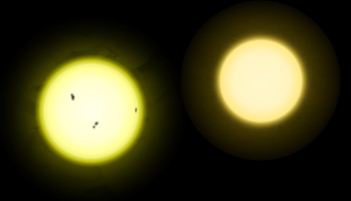
The planets detected in this work all come in at less than four Earth masses, and two of them are getting attention because they are located near the inner and outer edges of the habitable zone respectively. Tau Ceti has always drawn our attention, being relatively close (12 light years) and a solitary G-class Sun-like star. No wonder it and Epsilon Eridani were the two targets Frank Drake chose for Project Ozma when he launched observational SETI in 1960.
Image: This illustration compares the somewhat larger and hotter Sun (left) to the relatively inactive star Tau Ceti. Credit: R.J. Hall / Wikimedia Commons.
The idea that there are planets around Tau Ceti is not new, but the current study, led by Fabo Feng (University of Hertfordshire, UK) re-examines the star and actually eliminates two of the candidate planets identified four years ago. Radial velocity depends on picking out the faint signature of planets against ‘noise’ such as activity on the surface of the star, the rotation of the star, and uneven sampling times from observations. This is why validating some RV planet candidates can be tricky. Feng and team, however, have applied a new method.
This is the same team that did the 2013 paper on Tau Ceti, using the nearby star as a test case for its methods. The idea was to examine how activity on Tau Ceti itself differed when observed in a range of wavelengths. The thinking here is that the ‘jitter’ in variations of the radial velocity signal is dependent on wavelength, which needs to be accounted for in the analysis.
To do this, the authors introduce what they call “differential RVs.” The radial velocity signals of planets do not depend on wavelength, so differential RVs are those that contain only the noise that needs to be screened. Working with 9000 measurements of the star from the HARPS spectroscope, including new measurements, the team found four strong planet candidates.
The signals are consistent with orbits of 20.0, 49.3, 160 and 642 days. This is an interesting mix given the earlier work, as it identifies two new RV signals (20 and 49.3 days), while tightening up the precision on the previously identified candidates at 160 and 600 days, and at the same time ruling out two of the candidates identified in 2013. “But no matter how we look at the star,” says Mikko Tuomi (University of Hertfordshire), “there seems to be at least four rocky planets orbiting it.”
We’re learning something crucial here about how radial velocity methods work. Remember that we thought for a time that we had identified a planet around Alpha Centauri B, a detection that was later acknowledged to be a mistake in the analysis. When we’re dealing with planets of roughly Earth’s size, the radial velocity signals we can expect even from nearby stars are well below 1 meter per second. The complexity of the problem in relation to Tau Ceti is evident:
The planetary candidates we have identified partially overlap with the ones found by MT13 [the authors’ 2013 paper on Tau Ceti RV analysis]. We find two new planetary candidates with periods around 20 and 49 d, but fail to confirm the signals around 14 and 35 d. Although there is evidence for the existence of the signal at around 92 d, we cannot confirm it as a Keplerian candidate because it cannot be consistently identified in all data sets and solutions. The signal around 14 d becomes weak when we subtract the 20 d signal from the data. But the opposite is not true, suggesting a non-Keplerian origin of the 14 d signal. Nevertheless, the 14 d signal does exist in some Keplerian and circular solutions after accounting for the 20 d signal. In addition, by evenly dividing the data into 3 chunks, we find that the 14 d is significant in the first chunk while the 20 d is significant in the second and third chunks…
And so on. The lesson is clear enough: We have to be extremely careful when interpreting signals below 1 meter per second, the range in which we’ll need to identify Earth-class planets.
But the value of radial velocity is unquestioned. Unlike the transit technique, we don’t have to rely on a fortuitous line-up between a distant planetary system and the Earth — we can therefore extend it to all bright stars of interest. Feng and colleagues think we will be able to use new high precision spectrometers along with these emerging statistical and noise models to find a true Earth analog in the coming decade. Thus this work on Tau Ceti, modeling wavelength-dependent noise, becomes a test case of a new noise model framework that can help us filter background noise out of RV observations.
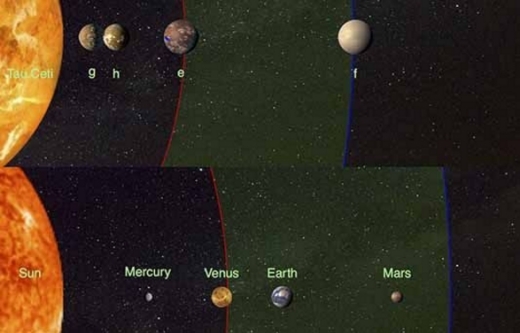
Image: The four planet candidates at Tau Ceti in comparison with our Solar System. Credit: University of Hertfordshire.
And while two of these planets (e and f) have been cited as being close to the boundaries of the habitable zone, the massive debris disk around Tau Ceti is going to be a factor in habitability in this system, leading to presumed cometary bombardment. We’ll want to learn more about the inner boundaries of the debris disk, and also whether the disk and planetary system orbit in the same plane, which would have a strong effect on the masses of these planet candidates. A co-planar disk brings the mass estimates of these four planets up sharply.
The paper is Feng et al., “Color difference makes a difference: four planet candidates around tau Ceti,” accepted at the Astronomical Journal (preprint).






August 15, 2017
TRAPPIST-1: The Importance of Age
If life can arise around red dwarf stars, you would think TRAPPIST-1 would be the place to look. Home to seven planets, this ultracool M8V dwarf star about 40 light years away in Aquarius has been around for a long time. The age range in a new study on the matter goes from 5.4 billion years up to almost ten billion years. And we have more than one habitable zone planet to look at.
Adam Burgasser (UC-San Diego) and Eric Mamajek (JPL) are behind the age calculations, which appear in a paper that has been accepted at The Astrophysical Journal. We have no idea how long it takes life to emerge, having only one example to work with, but it’s encouraging that we find evidence for it very early in Earth’s history, dating back some 3.8 billion years. But we also have much to learn about habitability around red dwarfs in general.
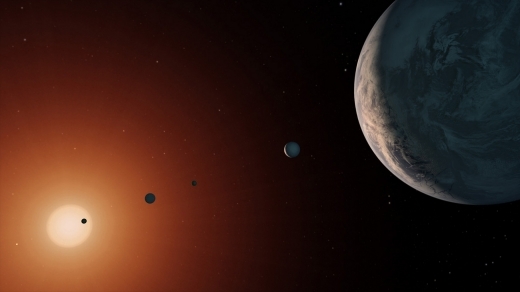
Image: This illustration shows what the TRAPPIST-1 system might look like from a vantage point near planet TRAPPIST-1f (at right). Credit: NASA/JPL-Caltech. [PG note to JPL: Please append artists’ names to such images! I want to credit the artist but have no idea who it is].
The good thing about being a somewhat older red dwarf is that flare activity should have slowed over time, a fact that the authors confirm. This doesn’t make it necessarily benign. In fact, as the paper points out, “…despite TRAPPIST-1’s modest emission as compared to other late-M dwarfs, the radiation and particle environment is still extreme as compared to the Earth.”
And because the habitable zone planets (e, f and g) around TRAPPIST-1 orbit as close to it as they do — all seven planets orbit within Mercury’s orbit around the Sun — they have long been exposed to radiation that could have destroyed their atmospheres and caused their oceans to evaporate. The orbital periods here range from 1.5 to 19 days, with orbital semi-major axes of 0.011-0.062 AU. Tight indeed!
The paper notes that based on current estimates, the high energy emissions of TRAPPIST-1 are probably enough to have evaporated an Earth’s ocean of water mass from each of the planets save the outer two over the lifetime of the stellar system. Another ominous note: The process of stripping an atmosphere can go into high gear when the magnetic field lines of a star interact with those of a planet, funneling stellar wind particles directly to the planet’s surface.
But we don’t know enough about these planets to make the call, and there are other factors that come into play, including the possibility of thick atmospheres. From the preprint:
… current estimates of the planets’ densities are generally below Earth’s average density (Gillon et al. 2017; Wang et al. 2017), suggesting volatile-rich worlds that may have ample reservoirs; while ocean evaporation and hydrogen loss could result in an oxygen- and ozone-rich atmosphere that could shield the surface from high UV fluxes (Luger & Barnes 2015; O’Malley James & Kaltenegger 2017). Transit spectroscopy measurements of the atmospheres of these planets are currently insufficient to detect the signatures of all but the lightest elements (de Wit et al. 2016), but the James Webb Space Telescope should have the sensitivity to detect Earth-like atmospheres around these planets, if they exist (Barstow & Irwin 2016).
So the key question is, will we find atmospheres on these planets when we have the technology in place to spot them? TRAPPIST-1 is close enough to the Earth that space-based assets should be able to give us an answer soon. You can see how significant the James Webb Space Telescope is as we look toward the future of characterizing Earth-mass planet atmospheres. A thick atmosphere can shield a planetary surface as well as redistributing heat from the dayside to the dark on these presumably tidally locked worlds. Too much of a good thing, of course, can lead to the kind of greenhouse effects that have so ravaged our neighboring world Venus.
Burgasser and Mamajek’s study is an important one, because age is critical for understanding the evolution of this star’s planetary system. The paper uses a variety of tools, ranging from average density to flare activity, lithium absorption, metallicity, kinematics, rotation and magnetic activity to make the call on age. Also a factor: How fast the star is moving in the galaxy.
The conclusion that TRAPPIST-1 is a far older star than previously thought has implications for the stability of the planetary system:
… N-body simulations presented in Gillon et al. (2017) showed the planetary system to be consistently unstable on timescales < 0.5 Myr, with only an 8% chance of surviving 1 Gyr. This is refuted by the much older age we infer for the TRAPPIST-1 star. However, recent simulations show that the resonant configuration of these planets is in fact highly stable through disk migration on timescales of 50 Myr (1010 orbits), with or without eccentricity dampening. That this system appears to have persisted for over 5 Gyr, despite dynamical interactions that are readily detectable through transit timing variations (Gillon et al. 2017; Wang et al. 2017), suggests that the resonant configuration is indeed inherently stable.
The current work has been done with data from the Spitzer space telescope, the continued use of which should help to tighten up estimates of the TRAPPIST-1 planet densities, which is also a factor as we try to determine their compositions. Further work with Hubble and, of course, with JWST should help us learn whether there are indeed atmospheres in this planetary system.
The paper is Burgasser & Mamajek, “On the Age of the TRAPPIST-1 System,” accepted at The Astrophysical Journal (preprint).






August 14, 2017
Laser SETI in Context
I’ve been thinking about SETI all weekend, not only because I’m pulling material together for the Tennessee Valley Interstellar Workshop in October, but also because I’ve been keeping an eye on the Laser SETI campaign now running on Indiegogo. With five days to go, Laser SETI is four-fifths of the way to its goal. When I think about the effort in the context of SETI’s history, its significance becomes ever more clear. Please give this campaign a look and help if you can.
The context I’m talking about relates to how we do SETI in a tight budgetary environment. Although it is not involved today, NASA was once a player in early studies, funding the work that produced the proposal for Project Cyclops, an enormous radio telescope array that was never built, although the ensuing report, Project Cyclops: A Design Study of a System for Detecting Extraterrestrial Intelligent Life, had influence throughout the young SETI community.
But SETI has always been controversial in some quarters, and while NASA did fund a Microwave Observing Program using instruments at the Deep Space Network, Green Bank (WV) and Arecibo, the program was canceled after objections in Congress. It was up to The SETI Institute to take the program forward with private funding under the name Project Phoenix. Under Jill Tarter’s guidance, the project targeted 800 stars within a roughly 200 light year range.
The context for SETI, then, if you look at the 100 or so SETI projects around the world since Project Ozma, is that private contributions play a huge role in keeping efforts like the Allen Telescope Array alive, while universities like UC-Berkeley rather than government agencies are behind projects like SETI@Home. I should also mention Project SERENDIP, likewise run by UC-Berkeley, and the SETI Australia Centre, which uses SERENDIP technologies at the Parkes instrument in New South Wales. The ongoing Breakthrough Listen initiative is another example, drawing on private capital to do visionary things that government fails to support.

In that spirit, the Laser SETI campaign carries us forward in striking ways. Let me quote Jill Tarter’s thoughts from an email this morning:
In 1981, Martin Harwit published Cosmic Discovery / The Search, Scope & Heritage of Astronomy. In this book he argued (citing plentiful precedents), that while we make arguments to potential funders about the questions that a new telescope, operating in virgin regions of observational phase space, will answer – in fact, the most important result from such a telescope, when it is built, will be to discover something nobody had ever anticipated! He argued for a funding policy that heavily encouraged exploration; if a new technology offers the opportunity to open up hitherto unobserved phase space, then fund it.
This is precisely what Laser SETI is doing by giving us the first opportunity to observe all the sky all the time, in search of transient optical phenomena. While the Laser SETI search algorithms are currently finely tuned to the discovery of monochromatic laser pulses from extraterrestrial technological civilizations, other algorithms can be developed that remove some of the specific filters intended to exclude everything but potential SETI signals. Indeed, if the sort of ‘Class A phenomena’ that Harwit documented are sufficiently bright, they could be captured by Laser SETI, perhaps even in the daylight sky. I’ve no idea what these things might be, but I’m convinced that it’s worth exploring. I hope that the astronomical community will join in the exploration.
I’ve written up the basics of Laser SETI in Laser SETI: All Sky All the Time, and I’ll send you there for detail about the hardware that this fundraiser supports. The crucial point is that we have the opportunity to look for laser signals — be they intentional beacons or the random activities of a civilization at work — with an unblinking stare that can pick up transient signals and determine if they repeat. The technology involved makes transients stand out against the background sky and is not dependent on being pointed at the right place at the right time.
How many transients are out there? We don’t know, but consider how long we’ve been doing astronomy before we detected the phenomenon known as Fast Radio Bursts (FRBs). These millisecond radio pulses are thought to occur by the thousands each day. As we puzzle out what they are, we’re reminded that we can’t hope to catalog transients — whether astrophysical phenomena or evidence of an extraterrestrial civilization — unless we can observe continuously.
The point bears repeating: If ET is bright but intermittent, all previous and current searches very likely won’t find it.

The Laser SETI cameras this campaign supports will localize targets on the sky and help us find out whether some of them are repeating. Going from two cameras, the campaign’s target, to multiple sites at six locations around the world would ensure all sky coverage full-time. But step one is to get the first two cameras operational. Eliot Gillum, the institute’s director of the optical SETI Program, leads this campaign. Here’s his take, from a recent email:
Laser SETI will explore like never before, looking for sub-minute transients across large swaths of the night sky. Its spectroscopic capabilities enable high time-resolution meteor burn analysis, discovery of new phenomena, or just more about known but perhaps incompletely understood events. And if it doesn’t make the most important discovery of all time by providing overwhelming evidence of a extraterrestrial signal, it will nonetheless have advanced the state of the art towards that goal in a significant and cost efficient way.
I want to add to that the fact that we can’t compartmentalize SETI operations from other investigations into the universe. We are doubtless going to learn a great deal about presumably natural phenomena like FRBs, and we’re certainly going to make entirely new discoveries in astrophysics. I think Jill Tarter has it precisely right when she cites Martin Harwit. As Harwit says, whenever we begin operations with a new kind of instrument, we may have an idea of what we are looking for, but invariably we discover things we had not anticipated.
Laser SETI should produce a similar result, becoming still more powerful as further sites come online. If SETI’s survival has always included scientists with enough passion for their work to surmount continuing budgetary constraints, then it’s good news that we live in an era when public participation can make a difference, playing a key role in getting new equipment online. Check the campaign and please help if you can as we try to get Laser SETI over the top.





August 11, 2017
More Provocative Data on MU69
Knowing that he was busy in Australia, I hadn’t thought that Alan Stern would get off a new report on New Horizons quite this fast (he wrote it over the Pacific on the flight back). But there’s enough here that I want to supplement this week’s earlier post about the three occultations of 2014 MU69, the distant Kuiper Belt Object toward which the spacecraft now moves at roughly a million kilometers a day. I’m also taken with an image in Stern’s latest, seen below. What we’re looking at is the spacecraft as it approaches what we now think may be a binary object, with the dense starfield in Sagittarius stretching out behind. Nice work by artist Carlos Hernandez.
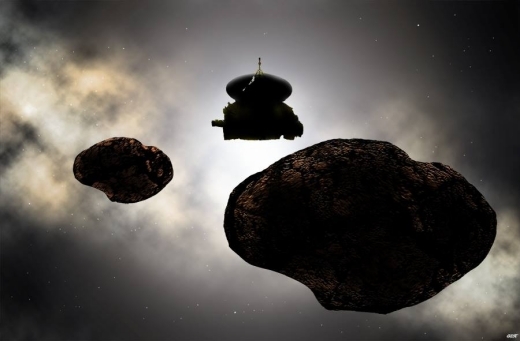
Image: Artist’s concept of the New Horizons spacecraft flying by a possible binary MU69 on Jan. 1, 2019. Credit: Carlos Hernandez.
The three occultations observed in June and July were examined in particular for evidence of debris, rings or other hazards that could cripple the spacecraft during the close approach. The encounter speed will be in the neighborhood of 14.2 kilometers per second, making even tiny pebbles a potential mission-ender. The work, involving two dozen telescopes and including data from the airborne NASA SOFIA observatory, produced no show-stoppers by way of debris but did give us the information that MU69 may be not one but two objects in close proximity.
All this has interesting implications, as we discussed on Tuesday. Here’s how Stern described the findings of the occultation effort, which was led by science team co-investigator Marc Buie:

The result Buie and Co. found was surprising and spectacular and scientifically seductive: MU69 appears to be either a binary orbiting pair or a contact (stuck together) pair of nearly like-sized bodies with diameters near 20 and 18 kilometers… This means we are very likely going to a primordial binary in the Kuiper Belt, a 4-billion-year-old relic of solar system formation and an exotic building block of the small planets of the Kuiper Belt like Pluto, Ixion, Makemake, Sedna and Eris.
Image: Marc Buie, New Horizons occultation campaign lead, holds up five fingers to represent the number of mobile telescopes in Argentina initially believed to have detected the fleeting shadow of 2014 MU69. The New Horizons spacecraft will fly by the ancient Kuiper Belt object on Jan. 1, 2019. Credit: NASA/Johns Hopkins University Applied Physics Laboratory/Southwest Research Institute/ Adriana Ocampo.
We also learn several new things from Stern’s report, written on his way back from the Deep Space Network (DSN) communications station outside Canberra in New South Wales. Astronomer Susan Benecchi (Planetary Science Institute) led studies with the Hubble Space Telescope this summer to examine MU69 from the standpoint of variations in brightness as it rotates on its axis, which could be an early clue to its shape and features.
The brightness variation turns out to be less than 20 percent, which implies that the object is either spherical in shape, or else is being observed with its pole pointed toward Earth. Perhaps both are true, but the finding adds to the suspense of the MU69 encounter as we try to reconcile a close binary with the Hubble brightness results. Have a look at the image below.
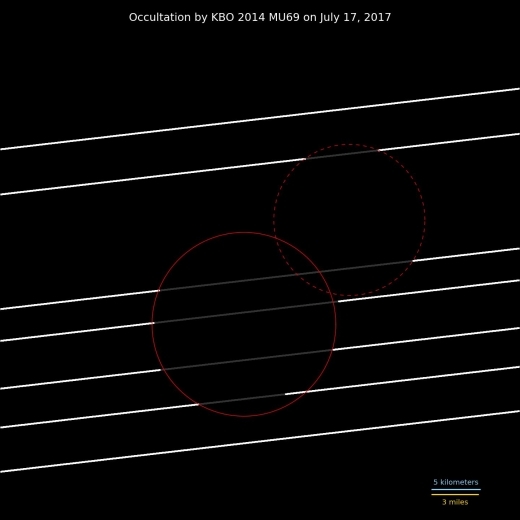
Image: MU69’s shadow traces its most likely binary shape, as seen in the stellar occultation that occurred over Argentina on July 17, 2017. The best-fit red circles reveal MU69’s possible doubled-lobed – or binary – nature. Credit: NASA/JHUAPL/SwRI/Alex Parker.
The flyby, scheduled for January 1, 2019, has now been moved forward by about an hour, an adjustment that, according to Stern, optimizes the viewing angles from the Canberra and Goldstone (CA) stations of the Deep Space Network. The team hopes to maximize the odds for measuring MU69’s mass by exquisitely precise tracking of New Horizons during the flyby. There will also be a DSN attempt to illuminate the KBO to measure its radar reflectivity.
Currently in a five-month hibernation period, New Horizons will ‘awaken’ on September 11, at which point instrument tests and observations, along with routine spacecraft maintenance, can continue. An improved suite of fault protection software, the last such upload, will be sent in early October. Stern explains the game plan going forward:
This fall, after New Horizons emerges from hibernation, we’ll craft the MU69 flyby observation plan in exquisite detail. We’ll also make more science observations of distant KBOs, and we’ll be continuously measuring the Kuiper Belt’s radiation, dust and gas environment. Near the end of this year, on Dec. 9, we’ll fire our engines to trim our course to and optimize the arrival time at MU69 as I described earlier. Then New Horizons will enter hibernation one last time, before the MU69 flyby begins late next summer. New exploration awaits us, at the very frontier of our solar system – late in 2018 and early in 2019, both of which are almost around the corner!
And let me throw in congratulations to Marc Buie and his colleagues. Remember that we are dealing with an object that is seven billion kilometers out, and no more than 30 kilometers in diameter. Imagine the faintness of the shadow thrown by these distant eclipses and consider what an extraordinary effort went into retrieving the data. Buie has truly pushed occultation science to a new level.






August 10, 2017
Cassini as Atmospheric Probe
I’m going to miss the Cassini mission as much as anyone, but I have to say it’s fascinating to watch how mission controllers are wringing good science out of every last moment of the spacecraft’s life. We’re now in the Grand Finale phase of the mission, in which Cassini has moved between the planet and its rings in a series of weekly dives. Now we’re about to push into a new series of close passes, actually moving through Saturn’s upper atmosphere.
Notice the language that Linda Spilker, Cassini project scientist at the Jet Propulsion Laboratory, uses to describe what’s next:
“As it makes these five dips into Saturn, followed by its final plunge, Cassini will become the first Saturn atmospheric probe. It’s long been a goal in planetary exploration to send a dedicated probe into the atmosphere of Saturn, and we’re laying the groundwork for future exploration with this first foray.”
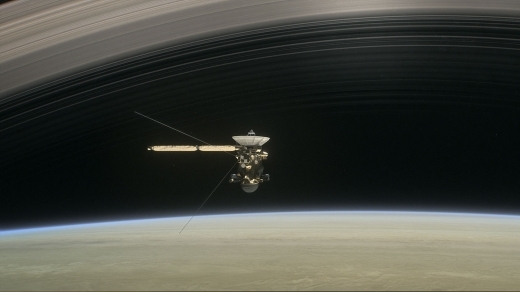
Image: This artist’s rendering shows Cassini as the spacecraft makes one of its final five dives through Saturn’s upper atmosphere in August and September 2017. Credit: NASA/JPL-Caltech.
Cassini as atmospheric probe? The mind boggles, but this will not be the first time the spacecraft has had to deal with an atmosphere. Those close flybys of Titan that produced so many spectacular findings about its atmosphere and surface required Cassini to use its rocket thrusters to maintain stability. You could consider the Titan flybys advanced preparation for this culminating act, and one in which the thrusters are being given wide margins for safety.
Consider the first atmospheric pass at Saturn, which will occur at 0022 EDT (0422 UTC) on Monday, August 14. The point of closest approach during these passes is to be between 1630 and 1710 kilometers above Saturn’s cloud tops. The built in margin is this: The thrusters are expected to operate somewhere between 10 and 60 percent of their capacity, the exact figure being determined by how stable the spacecraft remains through the procedure.
Anything beyond 60 percent means it proved harder to maintain stability than anticipated, a problem that would be corrected by a so-called ‘pop-up maneuver’ that will use the thrusters to increase the altitude of the later closest approaches by about 200 kilometers. Conversely, if no such maneuver is required, the orbit could be lowered as much as 200 kilometers on the last two orbits. In any case, a final ‘pop-down maneuver’ will occur on September 11, bending Cassini’s orbit (with the help of Titan) for the final plunge into the planet on September 15.
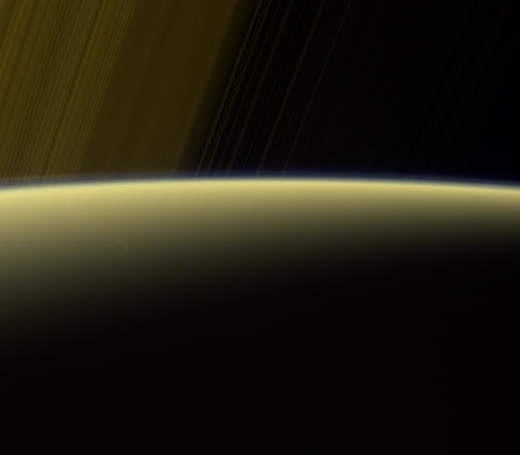
Image: This view from Cassini shows the narrow band of Saturn’s atmosphere, which Cassini will dive through five times before making its final plunge into the planet on Sept. 15. Credit: NASA/JPL-Caltech.
For now, we’ll be collecting data from Cassini’s ion and neutral mass spectrometer (INMS) to examine Saturn’s atmosphere, with other instruments producing high-resolution data on the planet’s auroras, atmospheric conditions and the vortices at the planet’s poles. Radar examination through the atmosphere should render features as small as 25 kilometers wide, about 100 times smaller than we’ve been able to obtain before the Grand Finale phase.
Cassini’s end on September 15 should be abrupt. With all seven of its science instruments reporting, the spacecraft will quickly reach an atmospheric density about twice what it should encounter during these final five passes. At that point, with the thrusters no longer able to maintain stability, Cassini’s antenna will lose its lock on Earth and we will lose contact.
Thinking about all that Cassini has given us, that’s a hard end to consider. But the spacecraft will be working until the last, augmenting the vast data flow we’ve received from Saturn. The discoveries we extract from Cassini’s mission will continue long after the probe is gone.






August 9, 2017
An Exoplanet with a Stratosphere
We’re beginning to find stratospheres on planets around other stars. A new study based at NASA Ames has looked closely at WASP-121b, a ‘hot Jupiter’ in its most extreme form. This is a planet about 1.2 times as massive as Jupiter, but with a radius almost twice Jupiter’s. The puffy world orbits its star in a scant 1.3 days (Jupiter, by contrast, circles the Sun every twelve years). As you would imagine, temperatures on WASP-121b are extreme, reaching 2500 degrees Celsius, which is enough to cause some metals to boil.
A stratosphere is simply a layer within an atmosphere where temperature increases with higher altitudes. Exactly how do scientists determine whether a planet fully 900 light years from Earth has such a layer? The answer is in the signature of hot water molecules, observed here by examining how these molecules in WASP-121b’s atmosphere react to specific wavelengths of light. The researchers used spectroscopic data from the Hubble instrument to make the call, knowing that cooler water vapor can block certain wavelengths from warmer layers below.
The brightness of the planet changes, in other words, at different wavelengths of light. When water molecules in the upper atmosphere are warmer than the layers below, as in a stratosphere, the molecules glow in the same infrared wavelengths that would be blocked by cooler air. The Ames team, led by lead author Tom Evans (University of Exeter) found exactly this signature in the Hubble data. Co-author Mark Marley (NASA Ames) describes the significance of the finding:
“This result is exciting because it shows that a common trait of most of the atmospheres in our solar system — a warm stratosphere — also can be found in exoplanet atmospheres. We can now compare processes in exoplanet atmospheres with the same processes that happen under different sets of conditions in our own solar system.”
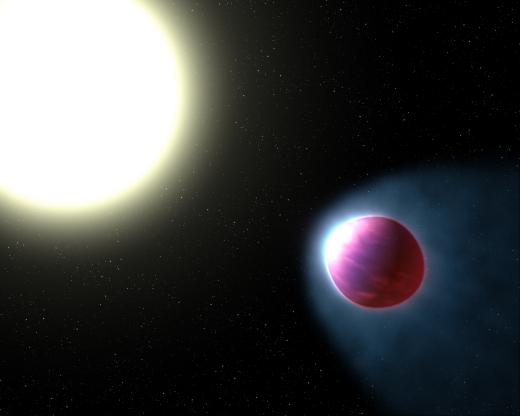
Image: This artist’s concept shows hot Jupiter WASP-121b, which presents the best evidence yet of a stratosphere on an exoplanet. Credit: Engine House VFX, At-Bristol Science Centre, University of Exeter.
Heated to the point that iron exists in gaseous rather than solid form, WASP-121b offers an extreme form of the stratospheres we’ve observed in the Solar System. Earth’s stratosphere gains a heat assist from the ozone that traps the Sun’s ultraviolet radiation. But we also find stratospheres in the outer system. Both Jupiter and Titan have stratospheres, with methane the likely source of heating. The change in temperatures in Solar System stratospheres is generally small, in the neighborhood of 55 degrees Celsius. On WASP-121b, that figure is 560° Celsius.
Researchers have found evidence for stratospheres on some exoplanets, but the WASP-121b work is the first time that water molecules have provided such clear-cut evidence. The authors point to vanadium oxide and titanium oxide gases as possible heat sources here, playing the role that ozone does in Earth’s stratosphere as they absorb starlight at visible wavelengths in the same way that ozone does in the infrared. We’ll learn more about this as the observing effort, which will study 20 different exoplanets over 800 hours of Hubble time, continues.
“This new research is the smoking gun evidence scientists have been searching for when studying hot exoplanets. We have discovered this hot Jupiter has a stratosphere, a common feature seen in most of our solar system planets.” says co-author David Sing (University of Exeter). “It’s a truly exciting find as we’re seeing dramatic differences planet-to-planet which is giving valuable clues in figuring out how planets behave under different conditions, and we’re only just scratching the surface of all the new Hubble data.”
Further Hubble data, of course, will eventually give way to follow-up by the James Webb Space Telescope, delving deeper into the question of stratosphere behavior at different longitudes on the planet. It’s likely that, given its extreme conditions (any closer to its star and WASP-121b could be torn apart), this planet will become a benchmark for atmospheric models. It’s also certainly a reminder of how we’re learning not only to detect exoplanet atmospheres but probe them, an effort we hope to continue on smaller, potentially habitable worlds soon.
The paper is Evans et al., “An ultrahot gas-giant exoplanet with a stratosphere,” Nature 548 (3 August 3 2017). Abstract available. For related work, see Haynes, “Spectroscopic Evidence for a Temperature Inversion in the Dayside Atmosphere of the Hot Jupiter WASP-33b,” Astrophysical Journal Vol. 806, No. 2 (12 June 2015). Abstract.






August 8, 2017
Tuning Up Asteroid Threat Mitigation
Some people tell me that the dangers posed by an asteroid or comet impact on Earth are over-publicized. Surely whatever object hits us would land some place harmless, causing nothing but a flurry of news stories. Others remind me that Chelyabinsk was seriously rattled by the explosion of a small asteroid in 2013, an event that could have created appalling damage with a slight deviation in trajectory. My own view is that guessing at the odds doesn’t do much for us. I favor a strong research effort into asteroid deflection and risk mitigation strategies.
Normally planetary protection wouldn’t be high on the agenda on Centauri Dreams because I focus on deep space issues and our exploration possibilities far from Earth. But asteroid deflection merits our attention because I’m convinced it is one of the drivers for space research. Protecting the planet means learning not only how to deflect potentially risky objects but also how to detect them long before they pose a problem. The two work together in that some impactors could come from far out in the system and need long-term strategies.
Thus I’m interested in learning that Vishnu Reddy of the University of Arizona’s Lunar and Planetary Laboratory is working with NASA’s Planetary Defense Coordination Office, the federal entity in charge of coordinating efforts to protect Earth from hazardous asteroids, on an observational campaign to test how well our networked resources might respond to a threat. Unlike earlier, similar exercises, this one engages our response to an actual near-Earth asteroid known as 2012 TC4. The Chelyabinsk reference comes in handy here — 2012 TC4 is thought to be roughly the same size as the asteroid that lit up the Chelyabinsk sky in 2013.
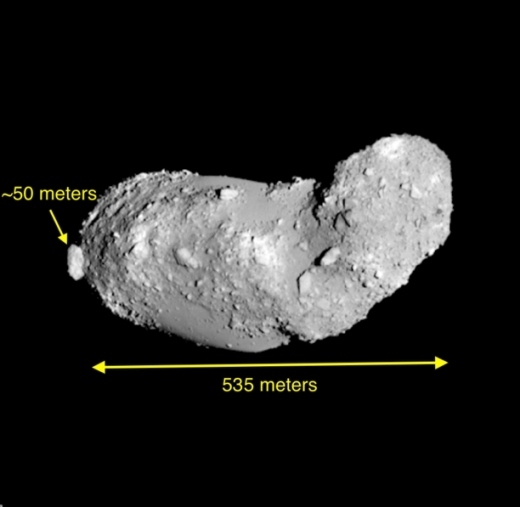
Image: No photos of asteroid 2012 TC4 exist, but this image of Itokawa, another near-Earth asteroid, helps visualize its approximate size: next to Itokawa, which is half a kilometer long, TC4 would appear about the same size as the “bunny tail” feature visible on the left. Credit: JAXA.
2012 TC4 was discovered by the Pan-STARRS 1 telescope on Oct. 5, 2012, at Haleakala Observatory (Maui). It is expected to pass as close as 6800 kilometers from the Earth on October 12 of this year. The idea of the exercise is to test systems involving observations, modeling, prediction and communications on an object that we can actually track.
When it becomes visible to Earth-based telescopes in early August, the asteroid’s orbit will need to be ‘recovered,’ meaning nailing down its parameters. Objects 50 meters across or less (about 12000 known near-Earth objects are larger than this) should disintegrate in the atmosphere, a heartening thought, though the 20-meter Chelyabinsk bolide, exploding high in the atmosphere, still resulted in thousands of injuries. The odds on a 1-kilometer or larger asteroid impacting the Earth are small, but exercises like this one will help test systems that one day might be called into play to evacuate an area where a small impactor might hit (see this interview with Paul Chodas, manager of the Center for Near-Earth Object Studies at JPL).
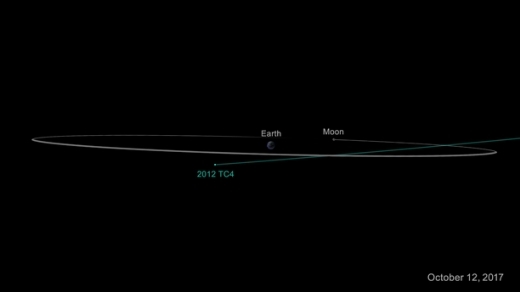
Image: On Oct. 12, 2017, asteroid 2012 TC4 will safely fly past Earth. Even though scientists cannot yet predict exactly how close it will approach, they are certain it will come no closer to Earth than 6,800 kilometers. Credit: NASA/JPL-Caltech.
More than a dozen observatories, universities and laboratories across the globe are involved in the upcoming 2012 TC4 flyby exercise. Let’s see how we do at pulling resources together to run an exercise on an actual flyby. Meanwhile, bear in mind that between 80 and 100 tons of various kinds of debris — dust, small asteroid fragments and so on — fall into the atmosphere every day.
Things falling down on us from above are, in other words, inevitable, but we’d like to know about the bigger stuff. Chelyabinsk-class events take place once or twice a century, but exactly when, given an NEO catalog that is incomplete, cannot always be predicted. Exercises like this one should help us tune up our response and suggest areas where we might improve.
Those other drivers for space exploration I mentioned earlier in today’s entry? To a large extent, they work in synchrony with asteroid mitigation. Astrobiology is clearly one, a search for the parameters of abiogenesis that dovetails with getting payloads to distant targets. An impact threat from further out in the Solar System than our population of near-Earth asteroids would demand proficiency at deep space propulsion and operations far from home. Add in the essential fact of human curiosity and the will to explore, and our push outward is sure to continue, whether with human crews or robotics, and despite inevitable budgetary constraints.






August 7, 2017
MU69 Occultations Yield KBO Data
Back in June we tracked what the New Horizons team was doing to refine our knowledge of 2014 MU69, the Kuiper Belt Object toward which New Horizons is now moving (see New Horizons: Occultations in Preparation for MU69). There were actually three of these events, on June 3, July 10 and July 17 of this year, studied not only by team members on the ground in Argentina and South Africa but by observatories like SOFIA (the airborne Stratospheric Observatory for Infrared Astronomy) and the Hubble Space Telescope. Hubble and the European Space Agency’s Gaia satellite were critical in calculating where the shadow of MU69 would fall.
Learning more about the distant KBO is a key part of the encounter, given the possibilities of debris around MU69 in the upcoming flyby. You’ll recall that the Pluto/Charon system was analyzed painstakingly in advance of the New Horizons flyby for the same reason. The occultations, in which the object passes in front of a distant star, allowed the team to take new readings on MU69, revealing that the KBO is no more than 30 kilometers long.
If, indeed, it is a single object. We may be dealing with what scientists involved with the project are calling an ‘extreme prolate spheroid’ (with an elongated, football-like shape (think American football as opposed to international). For that matter, we can’t rule out a binary, with two objects in close proximity or perhaps even touching (this is known as a contact binary).
“This new finding is simply spectacular. The shape of MU69 is truly provocative, and could mean another first for New Horizons going to a binary object in the Kuiper Belt,” said Alan Stern, mission principal investigator from the Southwest Research Institute (SwRI) in Boulder, Colorado. “I could not be happier with the occultation results, which promise a scientific bonanza for the flyby.”
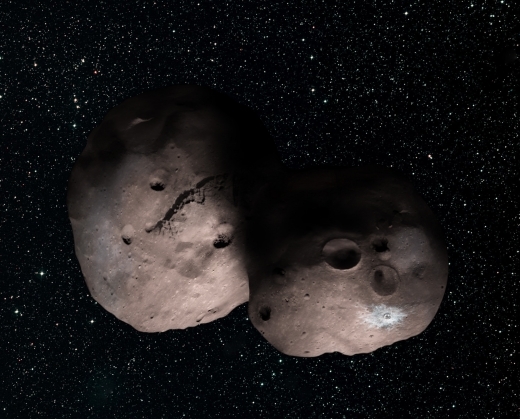
Image: One artist’s concept of Kuiper Belt object 2014 MU69, the next flyby target for NASA’s New Horizons mission. This binary concept is based on telescope observations made at Patagonia, Argentina on July 17, 2017 when MU69 passed in front of a star. New Horizons scientists theorize that it could be a single body with a large chunk taken out of it, or two bodies that are close together or even touching. Credit: NASA/Johns Hopkins University Applied Physics Laboratory/Southwest Research Institute/Alex Parker.
But as we ponder the results from the occultations, consider just how successful the effort has been. We’re tracking the shadow of an object as it passes in front of a star, the object being 6.5 billion kilometers from the Earth. More than sixty observers dealt with high winds and cold to set up 24 mobile telescopes in the area of Chubut and Santa Cruz, Argentina on July 17. Amanda Zangari (SwRI), a New Horizons co-investigator and the first to see the signature of MU69 in the occultation data, exulted over the team’s success: “We nailed it spectacularly.”
It’s also heartening to see the level of public support for this work in the Argentine community of Comodoro Rivadavia. Local authorities closed a national highway for two hours to prevent car headlights from interfering with the observations, and nearby street lights were turned off to ensure darkness. Local residents parked trucks to serve as windbreaks.

Image: NASA’s New Horizons team trained mobile telescopes on an unnamed star (circled) from a remote area of Argentina on July 17, 2017. A Kuiper Belt object 4.1 billion miles from Earth – known as 2014 MU69 – briefly blocked the light from the background star, in what’s known as an occultation. The time difference between frames is 200 milliseconds, or 0.2 seconds. This data will help scientists better measure the shape, size and environment around the object. The New Horizons spacecraft will fly by this ancient relic of solar system formation on Jan. 1, 2019. It will be the most distant object ever explored by a spacecraft. Click here to see a longer version of the occultation. Credit: NASA/Johns Hopkins University Applied Physics Laboratory/Southwest Research Institute/ Adriana Ocampo.
“This effort, spanning six months, three spacecraft, 24 portable ground-based telescopes, and NASA’s SOFIA airborne observatory was the most challenging stellar occultation in the history of astronomy, but we did it!” adds Alan Stern. “We spied the shape and size of 2014 MU69 for the first time, a Kuiper Belt scientific treasure we will explore just over 17 months from now. Thanks to this success we can now plan the upcoming flyby with much more confidence.”
So we proceed toward the most distant flyby in the history of space exploration, scheduled for January 1, 2019. A good deal of data analysis lies ahead for those studying the occultation results, but this most challenging ground occultation observation campaign in history has given us what we need. Be aware of the mission’s KBO Chasers page (and the hashtag #mu69occ) as you follow New Horizons’ next encounter online.






August 4, 2017
An Astrobiological Role for Titan’s Complex Chemistry?
Although Titan is often cited as resembling the early Earth, the differences are striking. Temperature is the most obvious, with an average of 95 Kelvin (-178 degrees Celsius), keeping water at the surface firmly frozen. Our planet was tectonically active in its infancy, roiled not only by widespread volcanism but also asteroid impacts, especially during the period known as the Late Heavy Bombardment some 4.1 to 3.8 billion years ago.
Throw in the fact that the Earth had high concentrations of carbon dioxide — Titan does not — and it’s clear that we can’t make too broad a comparison between the two worlds. What we do have on Titan, however, is an atmosphere that teems with chemical activity, fueled by light from the Sun and the charged particle environment in the moon’s orbit around Saturn. So we do have a chemistry here that is capable of turning simple organics into more complex ones.
Thus the findings from a new study of archival data using the Atacama Large Millimeter/submillimeter Array (ALMA) are instructive. If we can rule out forms of life as we know them, we can’t exclude combinations that could only form in Titan’s frigid incubator. A potential marker of such chemistry is vinyl cyanide (acrylonitrile), which has been identified in the study and points in interesting directions.
Says lead author Maureen Palmer (NASA GSFC): “The presence of vinyl cyanide in an environment with liquid methane suggests the intriguing possibility of chemical processes that are analogous to those important for life on Earth.”
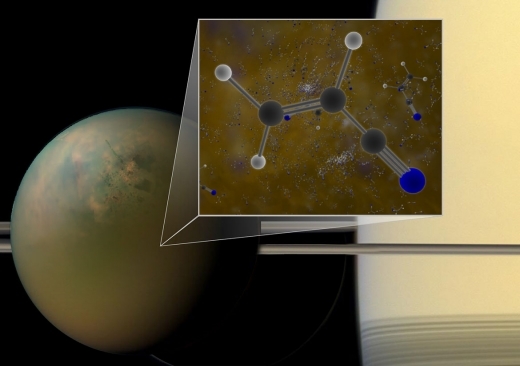
Image: Archival ALMA data have confirmed that molecules of vinyl cyanide reside in the atmosphere of Titan, Saturn’s largest moon. Titan is shown in an optical (atmosphere) infrared (surface) composite from NASA’s Cassini spacecraft. In a liquid methane environment, vinyl cyanide may form membranes. Credit: B. Saxton (NRAO/AUI/NSF); NASA.
An interesting thought, because the three signals Palmer and team found in millimeter wavelength spectra from ALMA observations in 2014 confirm what Cassini had already hinted at, which in turn reinforce laboratory simulations of Titan’s atmosphere. A surface rife with pools of hydrocarbons — and Titan is a place of methane rains, rivers and seas — could allow molecules of vinyl cyanide to link together, forming membranes that resemble the lipid-based cell membranes found on Earth. Titan’s complex organic molecules along with its nitrogen atmosphere and the presence of carbon-based molecules are provocative ingredients.
From the paper:
… lipid membranes, which are common to Earthly organisms, could not exist in cryogenic methane. Cell membrane–like compartments are crucial for the development of life from a sea of prebiotic reactants. These membranes enclose a small volume of solution, where reactants can be concentrated and (pre)biotic reactions can occur with greater frequency than they would in the dilute environment of an entire lake or sea. They also define individual cells as separate from each other, creating the potential for competition and natural selection.
And a nod to recent computational work on this matter:
Recent simulations have investigated some nitrile species for their potential to form flexible membranes in Titan-like conditions. These simulations suggest that vinyl cyanide (C2H3CN; also known as acrylonitrile or propenenitrile) would be the best candidate species for the formation of these hypothesized cell-like membranes, known as “azotosomes”
And now we have vinyl cyanide confirmed on Titan. At Cornell University, Jonathan Lunine worked with Paulette Clancy on a 2015 paper that discussed molecular simulation and its predictions as windows into prebiotic life conditions. Of the ALMA finding, Lunine says this:
“Researchers definitively discovered the molecule, vinyl cyanide (a.k.a. acrylonitrile), that is our best candidate for a ‘protocell’ that might be stable and flexible in liquid methane. This is a step forward in understanding whether Titan’s methane seas might host an exotic form of life. Saturn’s moon, Enceladus is the place to search for life like us, life that depends on — and exists in — liquid water. Titan, on the other hand, is the place to go to seek the outer limits of life — can some exotic type of life begin and evolve in a truly alien environment, that of liquid methane?”
And let’s not forget what else has been demonstrated by this work. What Lunine, Paulette Clancy and James Stevenson modeled in 2015 was exactly the kind of membrane we are now discussing. The finding of vinyl cyanide thus validates the authors’ 2015 paper, pointing to the value of molecular simulations as an adjunct to experimental and observational data.
The next steps? Further laboratory studies of the reactions involving vinyl cyanide. The authors point out that experimental work on membrane formation in cryogenic methane would help us determine just how viable a pathway this might be for astrobiology. We can also use infrared observations of Titan to study the transport of vinyl cyanide to the surface and map its spatial distribution, especially over the moon’s northern seas and lakes.
The paper is Palmer et al., “ALMA Detection and Astrobiological Potential of Vinyl Cyanide on Titan,” Science Advances Vol. 3, No. 7 (28 July 2017) (full text). The 2015 paper on modeling prebiotic environments is Stevenson, Lunine & Clancy, “Membrane alternatives in worlds without oxygen: Creation of an azotosome,” Science Advances Vol. 1, No. 1 (27 February 2015) (full text).






Paul Gilster's Blog
- Paul Gilster's profile
- 7 followers




